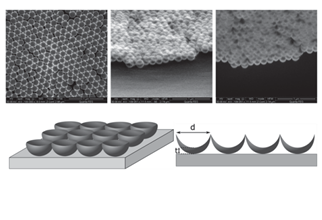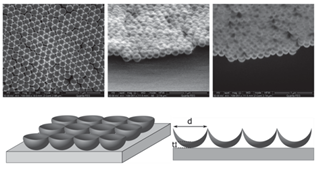Materials able to efficiently absorb electromagnetic radiation are helpful for different applications (e.g., energy harvesting, photothermal energy applications, or mechanical actuators). The current plasmonic metamaterials used in photovoltaic fields are expensive and employed in several application fields, so new alternatives that use cheaper materials are highly relevant for the sector.
Researchers from the Spanish National Research Council (CSIC) and the Catalan Institute of Nanoscience and Nanotechnology (ICN2-BIST) have developed a new metamaterial capable of absorbing light in an ample spectrum range and convert it into heat with high efficiency. This ability is achieved by the combination of nanostructured metallic elements, which can be found abundantly in nature and that are generally low-cost, together with polymeric films.
The structure of the material is composed by:
– A polymeric substrate, preferably from polydimethylsiloxane (PDMS) or polystyrene.
– Several nanoindentations of metallic elements such as Fe, Co, Ni, or alloys. Each structure is arranged in contact with the polymeric substrate at its vertices (concave side).
It can be used for the following applications:
- For energy applications, the invention could fulfill a wide arrange of different purposes, such as: energy harvesting, photothermal energy applications, catalytic reactions, or the development of mechanical actuators that could be powered by sunlight, for example.
- Another possible application would be in the ophthalmology area, for the manufacturing of dynamic irises to treat pupil disorders.
Scanning Electron Microscopy (SEM) images of the material and schematic of the target material for techtransfer
Benefits:
- It is a material that absorbs in a broader spectrum range (at an average absorption rate of 84% in the range of 300 to 18000 nm).
- The absorption of electromagnetic radiation (light) is independent of the angle of incidence of this light.
- The photothermal conversion efficiency is higher, doubling the one presented by typical plasmonic materials (e.g., Au, Ag, Al) currently used in industrial applications.
- The metallic materials used to manufacture the metamaterial are cheaper than the conventional ones. It can be set in complex 3D substrates, by using pulverization methods.
- It is a flexible material, which allows its usage on flat or curved surfaces.
- The ferromagnetic properties of the proposed materials enable the detection or combined actuation with light and magnetic fields.
A patent application has been filed for the present invention.
The represented institution is looking for a collaboration that leads to commercial exploitation of the presented invention.
Institution: ICN2 (Catalan Institute of Nanoscience and Nanotechnology), XRE4S (R+D+I Network Energy for Society) & CSIC (Spanish National Research Council)
TRL: 3-4
Protection status: Patent Application
Contact: Pablo Lago / pablo@viromii.com


